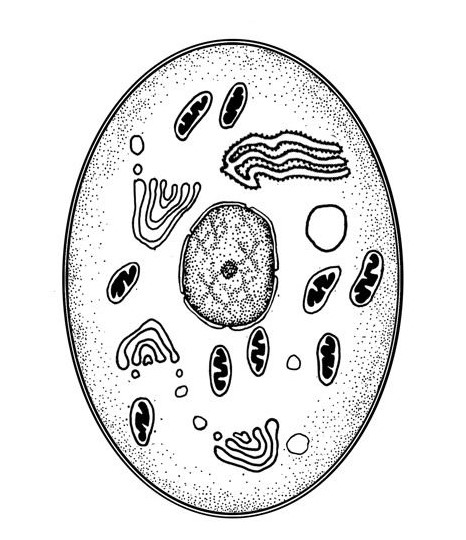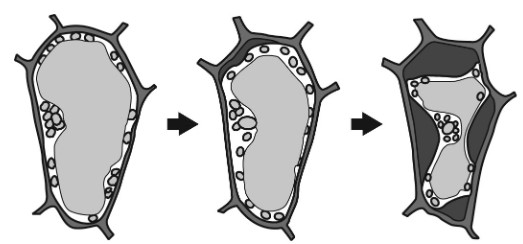Which of the following is NOT part of cell theory?
A) Cells come from pre-existing cells
B) Cells are the basic unit of life
C) All living things are made from cells
D) All cells have a nucleus
D) All cells have a nucleus
The endosymbiotic theory is used to describe the evolution of _________ cells.
A) eukaryotic
B) prokaryotic
C) virus
A) eukaryotic
Which best explains why a bacterial cell is classified as a prokaryote?
A) The presence of a nucleus
B) The presence of a cell wall
C) The absence of a nucleus
D) The absence of a cell wall
C) The absence of a nucleus
Which organelle is responsible for producing ATP (adenosine triphosphate) through cellular respiration
A) Golgi apparatus
B) Mitochondria
C) Endoplasmic reticulum
D) Nucleus
B) Mitochondria
Osmosis is the diffusion of ______________.
A) energy
B) air
C) proteins
D) water
D) water
Which scientist is responsible for naming cells?
A) Hooke
B) Leeuwenhoek
C) Virchow
D) Schwann
A) Hooke
According to endosymbiotic theory, chloroplasts and mitochondria used to exist outside of eukaryotic cells as _____________.
A) fungi
B) bacteria
C) microtubules
D) animalcules
B) bacteria
Which cellular component identifies the cell shown as a eukaryotic cell? 
A) nucleus
B) cytoplasm
C) ribosomes
D) cell membrane
A) nucleus
Compare and contrast plant and animal cells. Which statement is true?
A) Only animal cells have mitochondria
B) Only plant cells have chloroplasts
C) Only animal cells have a cell wall
D) Only plant cells have a nucleus
B) Only plant cells have chloroplasts
Which of the following best describes passive transport across a cell membrane?
A) Movement of molecules that requires ATP energy
B) Movement of molecules from high to low concentration without energy
C) Movement of molecules against their concentration gradient
D) Active pumping of substances through protein channels
B) Movement of molecules from high to low concentration without energy
What important discovery by Rudolf Virchow contributed to modern cell theory?
A) The existence of bacteria
B) The structure of DNA
C) All cells come from pre-existing cells
D) The presence of a cell membrane
C) All cells come from pre-existing cells
Which of the following definitions BEST describes endosymbiosis?
A) The process of one organism living inside another organism
B) The process of one organism fighting another organism
C) The process of two organisms competing for resources
D) The process of asexual reproduction in bacteria
A) The process of one organism living inside another organism
Which of the following correctly identifies a basic difference between prokaryotic and eukaryotic cells?
A) Prokaryotic cells are larger than eukaryotic cells
B) Prokaryotic cells lack a cell membrane
C) Prokaryotic cells lack a nucleus
D) Prokaryotic cells contain multiple chromosomes
C) Prokaryotic cells lack a nucleus
A student observes a cell under a microscope and notices it lacks a nucleus but contains ribosomes. What type of cell is this most likely to be?
A) A plant cell
B) A bacterial cell
C) An animal cell
D) A fungal cell
B) A bacterial cell
Compare and contrast diffusion and facilitated diffusion. Which statement is accurate?
A) Diffusion requires energy while facilitated diffusion does not
B) Both types require ATP to function
C) Facilitated diffusion uses transport proteins while simple diffusion does not
D) Both types move substances against their concentration gradient
C) facilitated diffusion
Heather and Lauren have discovered a new structure while evaluating a water sample from a local pond. They are trying to determine if the structure is alive. Which of the following pieces of evidence would support that the structure is NOT alive?
A) The structure contains genetic material
B) The structure is not made from cells
C) The structure can reproduce independently
D) The structure is composed of biomolecules
B) The structure is not made from cells
Which cellular organelles are believed to have originated through endosymbiosis?
A) Nucleus and Golgi apparatus
B) Mitochondria and chloroplasts
C) Endoplasmic reticulum and ribosomes
D) Lysosomes and vacuoles
B) Mitochondria and chloroplasts
Which of the following combinations correctly matches cell types with their characteristics?
A) Virus cells - no cell wall, has chloroplasts
B) Animal cells - has cell wall, no chloroplasts
C) Plant cells - has cell wall, has chloroplasts
D) Bacterial cells - has nucleus, has cell wall
C) Plant cells - has cell wall, has chloroplasts
A scientist observes a cell that is actively producing large amounts of proteins for export. Which cellular structure would likely be most abundant in this cell?
A) Lysosomes
B) Chloroplasts
C) Rough endoplasmic reticulum
D) Smooth endoplasmic reticulum
C) Rough endoplasmic reticulum
In a laboratory experiment, cells are placed in a solution where the solute concentration outside the cell is higher than inside. What type of solution is this?
A) Isotonic
B) Hypotonic
C) Hypertonic
D) Osmotonic
C) Hypertonic
Which of the following observations provides the strongest evidence to support cell theory?
A) Cells can divide to form identical daughter cells
B) All living things contain carbon
C) All organisms respond to stimuli
D) All living things need energy to survive
A) Cells can divide to form identical daughter cells
Which of the following pieces of evidence would best support the endosymbiotic theory?
A) Both mitochondria and chloroplasts have cell walls
B) Both mitochondria and chloroplasts have cytoplasm
C) Mitochondria and chloroplasts have their own DNA and ribosomes
D) Mitochondria and chloroplasts are found in all types of cells
C) Mitochondria and chloroplasts have their own DNA and ribosomes
Consider a cell that contains membrane-bound organelles, multiple chromosomes in a nucleus, but no chloroplasts or cell wall. This cell is most likely:
A) A bacterial cell
B) A plant cell
C) An animal cell
D) A virus
C) An animal cell
In a specialized muscle cell, what structure would you expect to find a higher number of compared to other cell types, and why?
A) Nuclei - to store more genetic material
B) Ribosomes - to produce more proteins
C) Mitochondria - to generate more energy
D) Lysosomes - to break down more waste products
C) Mitochondria - to generate more energy
The image shows depicts a plant cell experiencing plasmolysis.

Which of these processes best explains what is occurring?
A) Water is moving into the cell, causing it to burst
B) Proteins are actively being transported out of the cell
C) The cell membrane is detaching from the cell wall due to water loss
D) Oxygen is being actively pumped into the cell
C) The cell membrane is detaching from the cell wall due to water loss